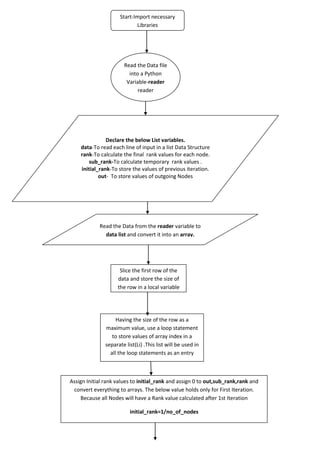Page Rank Algorithm
•
0 likes•139 views
The document describes the process for calculating page rank values for nodes in a network. It involves: 1) Reading network data from a file into variables, including the number of outgoing links for each node. 2) Calculating subrank values for each node by taking the initial rank of incoming nodes divided by the number of outgoing links. 3) Calculating the final rank value for each node based on its initial rank and the subrank values. 4) Repeating the subrank and rank calculation steps, updating the initial ranks for the next iteration.
Report
Share
Report
Share
Download to read offline

Recommended
More Related Content
What's hot
What's hot (20)
Implementation of queue using singly and doubly linked list.

Implementation of queue using singly and doubly linked list.
Similar to Page Rank Algorithm
Similar to Page Rank Algorithm (20)
C++ Sorting The parameter to the following two recursive routines is.pdf

C++ Sorting The parameter to the following two recursive routines is.pdf
Please help solve this in C++ So the program is working fin.pdf

Please help solve this in C++ So the program is working fin.pdf
In C++ please, do not alter node.hStep 1 Inspect the Node.h file.pdf

In C++ please, do not alter node.hStep 1 Inspect the Node.h file.pdf
Database object, sub query, Join Commands & Lab Assignment

Database object, sub query, Join Commands & Lab Assignment
Need done for Date Structures please! 4-18 LAB- Sorted number list imp.pdf

Need done for Date Structures please! 4-18 LAB- Sorted number list imp.pdf
Page Rank Algorithm
- 1. Read the Data file into a Python Variable-reader reader Slice the first row of the data and store the size of the row in a local variable Having the size of the row as a maximum value, use a loop statement to store values of array index in a separate list(Li) .This list will be used in all the loop statements as an entry criteria. Assign Initial rank values to initial_rank and assign 0 to out,sub_rank,rank and convert everything to arrays. The below value holds only for First Iteration. Because all Nodes will have a Rank value calculated after 1st Iteration initial_rank=1/no_of_nodes Start-Import necessary Libraries Declare the below List variables. data-To read each line of input in a list Data Structure rank-To calculate the final rank values for each node. sub_rank-To calculate temporary rank values . initial_rank-To store the values of previous iteration. out- To store values of outgoing Nodes Read the Data from the reader variable to data list and convert it into an array.
- 2. No Yes No Yes Yes Calculate the No of outgoing nodes (out) for each Node When n є Li if n=0 (Refers to the first Index value of list Li or 1st Iteration) Sub Rank Calculation: We declare 2 loops. The outer loop traverses through each row and inner through each column. We calculate Sub_Rank value for each Node. So when we are in the First row, it implies we are calculating Sub_Rank for 1st Node. Likewise when i=2 we are calculating Sub_Rank for 2nd Node. Sub_Rank[i]= Initial_Rank[j]/Out[j] +Sub_Rank[i] i=Row number(Here it means Node 1) j=Column Number(Here it means incoming nodes for Node 1) Rank Calculation: From the calculated values for each Node we calculate the Final Rank for each Node using a Separate loop. So for every Node we do the below Calculation. rank[i]=initial_rank[i]/no_of_nodes+(1- initial_rank[i])*(sub_rank[i])
- 3. We repeat the Sub Rank Calculation and Rank Calculation Steps again after we perform the below. initial_rank[i]=rank value from previous Iteration sub_rank[i]=0 End of Execution Once we get the Ranks of all Nodes, we do sort the Index of the Rank Array based on the values of the Array using argsort function under array class and then display the Ranks. Sample output: Rank-1= Node-2 Rank-2= Node-4 Rank-3= Node-1 Rank-4= Node-5 Rank-5= Node-3